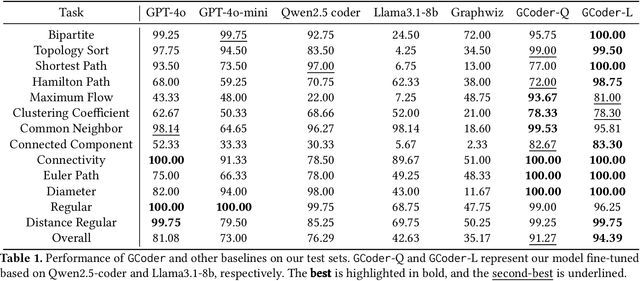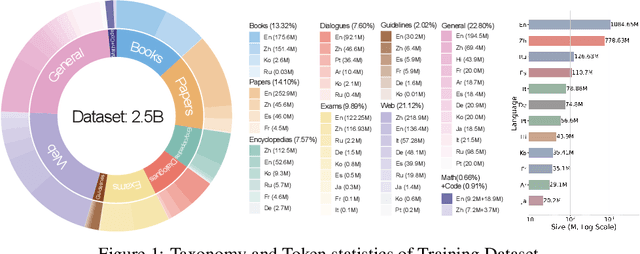Nuo Chen
JudgeLRM: Large Reasoning Models as a Judge
Mar 31, 2025Abstract:The rise of Large Language Models (LLMs) as evaluators offers a scalable alternative to human annotation, yet existing Supervised Fine-Tuning (SFT) for judges approaches often fall short in domains requiring complex reasoning. In this work, we investigate whether LLM judges truly benefit from enhanced reasoning capabilities. Through a detailed analysis of reasoning requirements across evaluation tasks, we reveal a negative correlation between SFT performance gains and the proportion of reasoning-demanding samples - highlighting the limitations of SFT in such scenarios. To address this, we introduce JudgeLRM, a family of judgment-oriented LLMs trained using reinforcement learning (RL) with judge-wise, outcome-driven rewards. JudgeLRM models consistently outperform both SFT-tuned and state-of-the-art reasoning models. Notably, JudgeLRM-3B surpasses GPT-4, and JudgeLRM-7B outperforms DeepSeek-R1 by 2.79% in F1 score, particularly excelling in judge tasks requiring deep reasoning.
CapArena: Benchmarking and Analyzing Detailed Image Captioning in the LLM Era
Mar 16, 2025Abstract:Image captioning has been a longstanding challenge in vision-language research. With the rise of LLMs, modern Vision-Language Models (VLMs) generate detailed and comprehensive image descriptions. However, benchmarking the quality of such captions remains unresolved. This paper addresses two key questions: (1) How well do current VLMs actually perform on image captioning, particularly compared to humans? We built CapArena, a platform with over 6000 pairwise caption battles and high-quality human preference votes. Our arena-style evaluation marks a milestone, showing that leading models like GPT-4o achieve or even surpass human performance, while most open-source models lag behind. (2) Can automated metrics reliably assess detailed caption quality? Using human annotations from CapArena, we evaluate traditional and recent captioning metrics, as well as VLM-as-a-Judge. Our analysis reveals that while some metrics (e.g., METEOR) show decent caption-level agreement with humans, their systematic biases lead to inconsistencies in model ranking. In contrast, VLM-as-a-Judge demonstrates robust discernment at both the caption and model levels. Building on these insights, we release CapArena-Auto, an accurate and efficient automated benchmark for detailed captioning, achieving 94.3% correlation with human rankings at just $4 per test. Data and resources will be open-sourced at https://caparena.github.io.
SolBench: A Dataset and Benchmark for Evaluating Functional Correctness in Solidity Code Completion and Repair
Mar 03, 2025Abstract:Smart contracts are crucial programs on blockchains, and their immutability post-deployment makes functional correctness vital. Despite progress in code completion models, benchmarks for Solidity, the primary smart contract language, are lacking. Existing metrics like BLEU do not adequately assess the functional correctness of generated smart contracts. To fill this gap, we introduce SolBench, a benchmark for evaluating the functional correctness of Solidity smart contracts generated by code completion models. SolBench includes 4,178 functions from 1,155 Ethereum-deployed contracts. Testing advanced models revealed challenges in generating correct code without context, as Solidity functions rely on context-defined variables and interfaces. To address this, we propose a Retrieval-Augmented Code Repair framework. In this framework, an executor verifies functional correctness, and if necessary, an LLM repairs the code using retrieved snippets informed by executor traces. We conduct a comprehensive evaluation of both closed-source and open-source LLMs across various model sizes and series to assess their performance in smart contract completion. The results show that code repair and retrieval techniques effectively enhance the correctness of smart contract completion while reducing computational costs.
Task-Oriented 6-DoF Grasp Pose Detection in Clutters
Feb 24, 2025Abstract:In general, humans would grasp an object differently for different tasks, e.g., "grasping the handle of a knife to cut" vs. "grasping the blade to hand over". In the field of robotic grasp pose detection research, some existing works consider this task-oriented grasping and made some progress, but they are generally constrained by low-DoF gripper type or non-cluttered setting, which is not applicable for human assistance in real life. With an aim to get more general and practical grasp models, in this paper, we investigate the problem named Task-Oriented 6-DoF Grasp Pose Detection in Clutters (TO6DGC), which extends the task-oriented problem to a more general 6-DOF Grasp Pose Detection in Cluttered (multi-object) scenario. To this end, we construct a large-scale 6-DoF task-oriented grasping dataset, 6-DoF Task Grasp (6DTG), which features 4391 cluttered scenes with over 2 million 6-DoF grasp poses. Each grasp is annotated with a specific task, involving 6 tasks and 198 objects in total. Moreover, we propose One-Stage TaskGrasp (OSTG), a strong baseline to address the TO6DGC problem. Our OSTG adopts a task-oriented point selection strategy to detect where to grasp, and a task-oriented grasp generation module to decide how to grasp given a specific task. To evaluate the effectiveness of OSTG, extensive experiments are conducted on 6DTG. The results show that our method outperforms various baselines on multiple metrics. Real robot experiments also verify that our OSTG has a better perception of the task-oriented grasp points and 6-DoF grasp poses.
RankFlow: A Multi-Role Collaborative Reranking Workflow Utilizing Large Language Models
Feb 04, 2025Abstract:In an Information Retrieval (IR) system, reranking plays a critical role by sorting candidate passages according to their relevance to a specific query. This process demands a nuanced understanding of the variations among passages linked to the query. In this work, we introduce RankFlow, a multi-role reranking workflow that leverages the capabilities of Large Language Models (LLMs) and role specializations to improve reranking performance. RankFlow enlists LLMs to fulfill four distinct roles: the query Rewriter, the pseudo Answerer, the passage Summarizer, and the Reranker. This orchestrated approach enables RankFlow to: (1) accurately interpret queries, (2) draw upon LLMs' extensive pre-existing knowledge, (3) distill passages into concise versions, and (4) assess passages in a comprehensive manner, resulting in notably better reranking results. Our experimental results reveal that RankFlow outperforms existing leading approaches on widely recognized IR benchmarks, such as TREC-DL, BEIR, and NovelEval. Additionally, we investigate the individual contributions of each role in RankFlow. Code is available at https://github.com/jincan333/RankFlow.
What Limits LLM-based Human Simulation: LLMs or Our Design?
Jan 15, 2025Abstract:We argue that advancing LLM-based human simulation requires addressing both LLM's inherent limitations and simulation framework design challenges. Recent studies have revealed significant gaps between LLM-based human simulations and real-world observations, highlighting these dual challenges. To address these gaps, we present a comprehensive analysis of LLM limitations and our design issues, proposing targeted solutions for both aspects. Furthermore, we explore future directions that address both challenges simultaneously, particularly in data collection, LLM generation, and evaluation. To support further research in this field, we provide a curated collection of LLM-based human simulation resources.\footnote{https://github.com/Persdre/llm-human-simulation}
Data Driven Automatic Electrical Machine Preliminary Design with Artificial Intelligence Expert Guidance
Nov 18, 2024



Abstract:This paper presents a data-driven electrical machine design (EMD) framework using wound-rotor synchronous generator (WRSG) as a design example. Unlike traditional preliminary EMD processes that heavily rely on expertise, this framework leverages an artificial-intelligence based expert database, to provide preliminary designs directly from user specifications. Initial data is generated using 2D finite element (FE) machine models by sweeping fundamental design variables including machine length and diameter, enabling scalable machine geometry with machine performance for each design is recorded. This data trains a Metamodel of Optimal Prognosis (MOP)-based surrogate model, which maps design variables to key performance indicators (KPIs). Once trained, guided by metaheuristic algorithms, the surrogate model can generate thousands of geometric scalable designs, covering a wide power range, forming an AI expert database to guide future preliminary design. The framework is validated with a 30kVA WRSG design case. A prebuilt WRSG database, covering power from 10 to 60kVA, is validated by FE simulation. Design No.1138 is selected from database and compared with conventional design. Results show No.1138 achieves a higher power density of 2.21 kVA/kg in just 5 seconds, compared to 2.02 kVA/kg obtained using traditional method, which take several days. The developed AI expert database also serves as a high-quality data source for further developing AI models for automatic electrical machine design.
GCoder: Improving Large Language Model for Generalized Graph Problem Solving
Oct 24, 2024



Abstract:Large Language Models (LLMs) have demonstrated strong reasoning abilities, making them suitable for complex tasks such as graph computation. Traditional reasoning steps paradigm for graph problems is hindered by unverifiable steps, limited long-term reasoning, and poor generalization to graph variations. To overcome these limitations, we introduce GCoder, a code-based LLM designed to enhance problem-solving in generalized graph computation problems. Our method involves constructing an extensive training dataset, GraphWild, featuring diverse graph formats and algorithms. We employ a multi-stage training process, including Supervised Fine-Tuning (SFT) and Reinforcement Learning from Compiler Feedback (RLCF), to refine model capabilities. For unseen tasks, a hybrid retrieval technique is used to augment performance. Experiments demonstrate that GCoder outperforms GPT-4o, with an average accuracy improvement of 16.42% across various graph computational problems. Furthermore, GCoder efficiently manages large-scale graphs with millions of nodes and diverse input formats, overcoming the limitations of previous models focused on the reasoning steps paradigm. This advancement paves the way for more intuitive and effective graph problem-solving using LLMs. Code and data are available at here: https://github.com/Bklight999/WWW25-GCoder/tree/master.
Efficiently Democratizing Medical LLMs for 50 Languages via a Mixture of Language Family Experts
Oct 14, 2024



Abstract:Adapting medical Large Language Models to local languages can reduce barriers to accessing healthcare services, but data scarcity remains a significant challenge, particularly for low-resource languages. To address this, we first construct a high-quality medical dataset and conduct analysis to ensure its quality. In order to leverage the generalization capability of multilingual LLMs to efficiently scale to more resource-constrained languages, we explore the internal information flow of LLMs from a multilingual perspective using Mixture of Experts (MoE) modularity. Technically, we propose a novel MoE routing method that employs language-specific experts and cross-lingual routing. Inspired by circuit theory, our routing analysis revealed a Spread Out in the End information flow mechanism: while earlier layers concentrate cross-lingual information flow, the later layers exhibit language-specific divergence. This insight directly led to the development of the Post-MoE architecture, which applies sparse routing only in the later layers while maintaining dense others. Experimental results demonstrate that this approach enhances the generalization of multilingual models to other languages while preserving interpretability. Finally, to efficiently scale the model to 50 languages, we introduce the concept of language family experts, drawing on linguistic priors, which enables scaling the number of languages without adding additional parameters.
Retrieving, Rethinking and Revising: The Chain-of-Verification Can Improve Retrieval Augmented Generation
Oct 08, 2024



Abstract:Recent Retrieval Augmented Generation (RAG) aims to enhance Large Language Models (LLMs) by incorporating extensive knowledge retrieved from external sources. However, such approach encounters some challenges: Firstly, the original queries may not be suitable for precise retrieval, resulting in erroneous contextual knowledge; Secondly, the language model can easily generate inconsistent answer with external references due to their knowledge boundary limitation. To address these issues, we propose the chain-of-verification (CoV-RAG) to enhance the external retrieval correctness and internal generation consistency. Specifically, we integrate the verification module into the RAG, engaging in scoring, judgment, and rewriting. To correct external retrieval errors, CoV-RAG retrieves new knowledge using a revised query. To correct internal generation errors, we unify QA and verification tasks with a Chain-of-Thought (CoT) reasoning during training. Our comprehensive experiments across various LLMs demonstrate the effectiveness and adaptability compared with other strong baselines. Especially, our CoV-RAG can significantly surpass the state-of-the-art baselines using different LLM backbones.
 Add to Chrome
Add to Chrome Add to Firefox
Add to Firefox Add to Edge
Add to Edge